new posts in all blogs
Viewing: Blog Posts Tagged with: new york times, Most Recent at Top [Help]
Results 51 - 75 of 161
How to use this Page
You are viewing the most recent posts tagged with the words: new york times in the JacketFlap blog reader. What is a tag? Think of a tag as a keyword or category label. Tags can both help you find posts on JacketFlap.com as well as provide an easy way for you to "remember" and classify posts for later recall. Try adding a tag yourself by clicking "Add a tag" below a post's header. Scroll down through the list of Recent Posts in the left column and click on a post title that sounds interesting. You can view all posts from a specific blog by clicking the Blog name in the right column, or you can click a 'More Posts from this Blog' link in any individual post.
We’re excited to announce that we now have over 2,000 titles available on the First Book Marketplace! Our award-winning online store carries books for children of all ages, from board books to college prep guides, from The Very Hungry Caterpillar to To Kill A Mockingbird.
 The First Book Marketplace is available to teachers and program leaders who serve children from low-income families, and we work hard to make sure that we’re able to offer high-quality titles that those teachers and program leaders tell us their kids want to read.
The First Book Marketplace is available to teachers and program leaders who serve children from low-income families, and we work hard to make sure that we’re able to offer high-quality titles that those teachers and program leaders tell us their kids want to read.
We’re proud of the Marketplace, and the diversity of quality books we’re able to offer our programs. David Bornstein wrote about the Marketplace recently in The New York Times:
The First Book Marketplace is trying to do for publishing what micro-finance did for banking: crack open a vast potential market that is underserved at significant social cost. The organization’s goal is to democratize book access, but along the way, it may end up reinvigorating the book business.
(If you’re curious about how the Marketplace works, why it’s so important, or why a nonprofit organization has an online bookstore, we recommend reading Bornstein’s piece, as well as his follow-up piece that addresses some specific questions about First Book’s model.)
We’ll be announcing some exciting new changes later this year that will make it even easier for the programs we work with to get books for the kids that need them, so keep in touch, and let us know what books the kids in your life are most excited about reading.


By: Kristin Nelson,
on 7/6/2011
Blog:
Pub Rants
(
Login to Add to MyJacketFlap)
JacketFlap tags:
news,
New York Times,
young adult,
fantasy,
romance,
USA Today,
literary fiction,
client books,
bestseller lists,
Add a tag
STATUS: Even though I look absolutely ridiculous doing a happy dance, I’m doing it anyway! White woman overbite. Here I come.
What’s playing on the XM or iPod right now? THE LOAD OUT by Jackson Browne
This is just getting impossible. If I keep hitting crazy milestones, what will I have to look forward to? Last year, I had 3 authors on the New York Times bestseller list at the same time.
Then it happened twice in one year. Fabulous. Where to go next?
How about 4 authors on the NYT list at the same time? And 3 of them on the top 150 USA Today Bestseller list at the same time as well.
Yep! That’s the news that hit my inbox about an hour ago. And here they are.
At #19 on the Trade Paperback list and #146 on USA Today
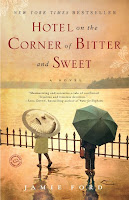
At #9 on the Children's list

At #11 on the Mass Market paperback list and #109 on USA Today

At #13 on the eBook listand #59 on USA Today

Whe

By: Michelle,
on 6/21/2011
Blog:
OUPblog
(
Login to Add to MyJacketFlap)
JacketFlap tags:
censorship,
New York Times,
gay,
lesbian,
US,
aids,
art,
homosexuality,
christopher,
museums,
imagery,
moma,
george segal,
*Featured,
reed,
Audio & Podcasts,
Art & Architecture,
Images & Slideshows,
christopher reed,
david wojnarowicz,
hide/sheek show,
pawnee,
stonewall riots,
overt,
Add a tag
By Justyna Zajac and Michelle Rafferty
“Growth of Overt homosexuality in City Provokes Wide Concern”
-New York Times (headline in 1963)
The world recoiled when the gay community started receiving credit for its influence in fashion and culture, but at least, according to Christopher Reed, they were being acknowledged. In his new book Art and Homosexuality: A History of Ideas, Reed argues that for some time the professional art world plain ignored the gay presence.
We had the chance to speak with Reed recently at his Williams Club talk, where he laid out the tumultuous relationship between art and activism. Below we present a few of the controversial things we learned.
1.) Art that didn’t get a chance…
During the most formative years of the gay rights movement in the 70s and on through the late 80s, arts publications and professionals, and even museums like the Museum of Modern Art, ignored imagery associated with gay and lesbian identity. Imagery like the graffiti pictured below which emerged in urban areas during the 70s:
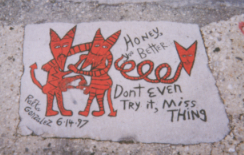
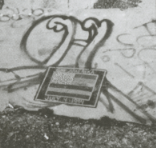
Grafitti on “The Rocks,” Lincoln Park, Chicago, mid-1990s.
According to Reed, “These sites of visual history were destroyed with no organized documentation when rising property values prompted local governments to reclaim these areas.”
2.) Censorship…
Is right for people to ban art today? Even if it’s in the imaginary town of Pawnee, Indiana? Reed surprised us with his answer, making us consider that there’s actually a worse kind of censorship. Listen below to hear what he said.
Transcript:
Censorship is an interesting question because there are overt examples of censorship like what just happened with the Hide/Seek show and the David Wojnarowicz piece, where particular politicians make a statement to their constituency by removing something that’s on exhibition. And then the kind of thing that you’re talking about where institutions simply don’t show things or don’t buy things – in the case of libraries – or don’t do things or don’t let particular people in, which often doesn’t read as censorship because people never realize what they could be seeing or could be reading, or could be going on, because the institution has already created a kind of logic in which that kind of thing doesn’t exist.
And so in a lot of ways I actually think that’s the most dangerous kind of censorship because people aren’t aware of it and they can’t make a

By: Lauren,
on 5/16/2011
Blog:
OUPblog
(
Login to Add to MyJacketFlap)
JacketFlap tags:
national mall,
*Featured,
disunion,
Art & Architecture,
Images & Slideshows,
charles lockwood,
district of columbia,
john lockwood,
Pennsylvania Avenue,
siege of washington,
washington dc history,
willard’s,
New York Times,
US,
civil war,
sesquicentennial,
washington,
Washington D.C.,
white house,
capitol,
Add a tag
By John Lockwood and Charles Lockwood
The Washington of April 1861—also commonly known as “Washington City”—was a compact town. Due to the cost of draining marshy land and the lack of reliable omnibus service, development was focused around Pennsylvania Avenue between the Capitol and White House. When the equestrian statue of George Washington was dedicated at Washington Circle in 1860, its location—three-quarters of a mile west of the White House, where Twenty-Third Street intersects Pennsylvania Avenue—was described as out of town. Several blocks north of the White House, at L Street, the land was countryside. “Go there, and you will find yourself not only out of town, away among the fields,” wrote English novelist Anthony Trollope in his travel account, North America, after his 1861 visit, “but you will find yourself beyond the fields, in an uncultivated, undrained wilderness.” A writer for the Atlantic Monthly, writing in January 1861, deemed Washington a “paradise of paradoxes,” foremost because it was both “populous” and “uninhabited” at once. Noting another paradox, he observed that the capital was ‘[d]efenceless, as regards walls, redoubts, moats, or other fortifications”—though the only party to “lay siege” to the city of late were the unyielding onslaught of politicians and office seekers, not soldiers.

Travelers arriving from northern cities caught a glimpse of the city’s grandeur and squalor as their train pulled into the B & O Station at the foot of Capitol Hill. “I looked out and saw a vast mass of white marble towering above us on the left . . . surmounted by an unfinished cupola, from which scaffold and cranes raised their black arms. This was the Capitol,” wrote Times of London correspondent William Russell, who arrived in Washington at the end of March 1861. “To the right was a cleared space of mud, sand, and fields, studded with wooden sheds and huts, beyond which, again, could be seen rudimentary streets of small red brick houses, and some church-spires above them.”
From the B & O Station, most carriages and hacks headed westward down Pennsylvania Avenue, the city’s main artery. The Avenue was the traditional route for grand parades between the Capitol and the White House, and by the mid-nineteenth-century, its north side was the location for the city’s finest hotels and shops. Yet many visitors, particularly those from leading cities like New York or London, were unimpressed by its pretensions to grandeur, and found the cityscape a formless jumble. Pennsylvania Avenue, observed Russell, was “a street of much breadth and length, lined with ailanthus trees . . . and by the most irregularly-built houses [and commercial buildings] in all kinds of materials, from deal plank to marble—of all heights.”
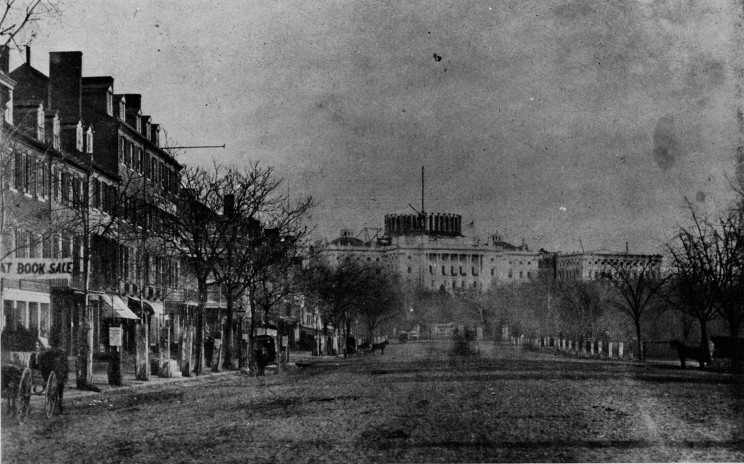
At the corner of Fourteenth Street, one block before Pennsylvania Avenue made its northward turn at the Treasury before continuing west past the White House, stood Willard’s Hotel. The hotel, favored by Republican Party leaders, was the center of Washington’s social and business life under the new administration. Willard’s contained “more scheming, plotting, planning heads, m

By: Anastasia Goodstein,
on 3/24/2011
Blog:
Ypulse
(
Login to Add to MyJacketFlap)
JacketFlap tags:
New York Times,
MTV,
youtube,
myspace,
Real World,
children's choice book awards,
Ypulse Essentials,
Friendster,
qr codes,
amanda hocking,
rebecca black,
apparel media,
billboard social chart,
synchtube,
Add a tag
 The Children’s Choice Book Awards (voting is open, with nominees from Suzanne Collins [Mockingjay] and Stephanie Meyer [The Second Short Life of Bree Tanner]. Elsewhere in YA news, Amanda Hocking, the self-publishing standout, lands a book... Read the rest of this post
The Children’s Choice Book Awards (voting is open, with nominees from Suzanne Collins [Mockingjay] and Stephanie Meyer [The Second Short Life of Bree Tanner]. Elsewhere in YA news, Amanda Hocking, the self-publishing standout, lands a book... Read the rest of this post

By: Lauren,
on 3/11/2011
Blog:
OUPblog
(
Login to Add to MyJacketFlap)
JacketFlap tags:
news,
New York Times,
US,
Politics,
bloggers,
Media,
journalism,
rolling stone,
*Featured,
john mcmillian,
leftist,
smoking typewriters,
underground press,
Add a tag
Following the lead of papers like the Los Angeles Free Press, the East Village Other, and the Berkeley Barb, young Americans in the 1960s launched hundreds of mimeographed pamphlets and flyers, small press magazines, and underground newspapers. New, cheaper printing technologies democratized the publishing process and by the decade’s end the combined circulation of underground papers stretched into the millions. Though not technically illegal, these papers were often genuinely subversive, and many of those who produced and sold them-on street-corners, at poetry readings, gallery openings, and coffeehouses-became targets of harassment from local and federal authorities. With writers who actively participated in the events they described, underground newspapers captured the zeitgeist of the ’60s, speaking directly to their readers, and reflecting and magnifying the spirit of cultural and political protest.
In the deeply researched and eloquently written volume Smoking Typewriters: The Sixties Underground Press and the Rise of Alternative Media in America, author John McMillian captures all the youthful idealism and vibrant tumult of the 1960s as it delivers a brilliant reappraisal of the origins and development of the New Left rebellion. McMillian pays special attention to the ways underground newspapers fostered a sense of community and played a vital role in shaping the New Left’s highly democratic “movement culture.” Below, we present a conversation with McMillian, who is also Assistant Professor of History at Georgia State University and the co-editor of The Radical Reader: A Documentary History of an American Radical Tradition, The New Left Revisited, Protest Nation: The Radical Roots of Modern America, The Sixties: A Journal of History, Politics and Culture
* * * * *
 How did you get interested in the 60s, and what made you want to write about that period?
How did you get interested in the 60s, and what made you want to write about that period?
I’ve had a longstanding layperson’s interest in the 1960s, going all the way back to high school, when I became a huge Beatles fan. I read about them obsessively, and then a little later on started getting interested in other iconic groups and personalities from the era: Abbie Hoffman, the Black Panthers, even Charles Manson (as weird as that sounds). But it wasn’t until a bit later – after I started my Ph.D. at Columbia in the mid-to-late 1990s – that it even occurred to me that this was a topic I could study professionally.
Up until that point, most of the writing on the 60s had been accomplished by people who had lived through the decade, and who (at least by some accounts) seemed a little protective of the field. But soon I discovered that a newer generation of scholars – made up of people who are just a little bit older than myself – were beginning to do some really fascinating work on the period. Meanwhile, I’d encountered essays by Maurice Isserman and Rick Perlstein, both of which were persuasive and encouraging about the idea that the scholarship on the 60s scholarship could use an infusion of fresh voices and new approaches. And then once I started doing just a little bit of work on the New Left, I realized there were so many amazing troves of untapped primary sources relating to the 60s (the underground newspapers are foremost among then). Most of the time, I really enjoy doing archival w
Have you been wondering how anyone could possibly read an entire book on an IPhone? On such a lilliputian screen, that’s like reading, say, “The Girl With the Dragon Tattoo” while looking at it through a keyhole. Wouldn’t it make sense to provide narratives chosen with the scale of the device in mind? After all, [...]
In case you were stuck working at 1:30 this afternoon and missed the great discussion between Lynn Nesbit, Carlo Rotella and Overlook publisher Peter Mayer about TRUE GRIT and Charles Portis, WNYC has helpfully put the interview online!
Listen below or go here to listen to the talk and read a bit of background.

By: Anastasia Goodstein,
on 1/31/2011
Blog:
Ypulse
(
Login to Add to MyJacketFlap)
JacketFlap tags:
McDonald's,
New York Times,
Uncategorized,
Disney,
Harper,
Dutton,
penguin,
FHM,
Youth Marketing,
Mashable,
Gilt Kids,
Add a tag
Today we bring you another installment of Youth Media Movers and Shakers. We've culled through industry publications looking for the recent executive placements we think you should know about. If you have executive news that you want us to highlight... Read the rest of this post

By: Michelle,
on 12/8/2010
Blog:
OUPblog
(
Login to Add to MyJacketFlap)
JacketFlap tags:
goodstein,
Religion,
myth,
ramadan,
Islam,
debate,
christianity,
terrorism,
christopher hitchens,
sehat,
George Bush,
muslim,
religious freedom,
hitchens,
Iran,
religious tolerance,
athiest,
Tariq Ramadan,
The Oxford Comment,
laurie goodstein,
*Featured,
david sehat,
myth of american religious freedom,
separation of church and state,
mafi,
New York Times,
Add a tag
In this two-part series, Michelle and Lauren explore some of the most hot-button issues in religion this past year.
Subscribe and review this podcast on iTunes!
Featured in Part 1:
Christopher Hitchens and Tariq Ramadan Debate: Is Islam a Religion a Peace?
Highlights and exclusive interviews with Hitchens, Ramadan, & New York Times National Religion Correspondent Laurie Goodstein
 Read more and watch a video courtesy of the 92nd St Y HERE.
Read more and watch a video courtesy of the 92nd St Y HERE.
* * * * *
Nick Mafi, Oxford University Press employee extraordinaire
* * * * *
David Sehat, author of The Myth of American Religious Freedom

* * * * *
The Ben Daniels Band


Check out the recent New ![iStock_000002070879Small[1]](http://blog.firstbook.org/wp-content/uploads/2010/11/iStock_000002070879Small1-300x225.jpg) York Time’s article, The D.I.Y. Foreign-Aid Revolution, which focuses on women who have found innovative ways to solve some of the world’s most challenging social issues. Among the social entrepreneurs mentioned is our very own president and CEO, Kyle Zimmer.
York Time’s article, The D.I.Y. Foreign-Aid Revolution, which focuses on women who have found innovative ways to solve some of the world’s most challenging social issues. Among the social entrepreneurs mentioned is our very own president and CEO, Kyle Zimmer.
Read the whole article at: http://www.nytimes.com/2010/10/24/magazine/24volunteerism-t.html?_r=1&scp=1&sq=kyle%20zimmer&st=cse


By: Lauren,
on 10/22/2010
Blog:
OUPblog
(
Login to Add to MyJacketFlap)
JacketFlap tags:
New York Times,
Literature,
Sociology,
American History,
Theater,
A-Featured,
A-Editor's Picks,
faulkner,
broadway,
f. scott fitzgerald,
gatsby,
hemingway,
bloomberg,
great gatsby,
new york daily news,
new york post,
city college,
gatz,
gun and the pen,
Keith Gandal,
public theater,
theatremania,
gandal,
fitzgerald’s,
Add a tag
By Keith Gandal
Want a quick, but apparently reliable measure of how elitist you are? Go see the 7-hour production of Gatz, in which all 47,000 words of F. Scott Fitzgerald’s The Great Gatsby are, in the course of the play, enunciated on stage. (If you dare and can afford to.) If you love every minute of it and find time flying by, you’re probably, well, an arts snob; if you find your reaction mixed, your mind drifting in and out, and your body just plain giving out, well, you’re likely more of a populist.
Consider the following small, statistically meaningless, but provocative sample of reviews you instantly encounter on the web: the New York Times, Bloomberg, and Theatremania all give the play rave reviews, while the New York Post and the New York Daily News both give it 2½ stars (out of 4 and 5 respectively). Ben Brantley of the New York Times describes the play as “work of singular imagination and intelligence.” Jeremy Gerard of Bloomberg calls it “remarkable,” “as powerful a piece of stagecraft as you may ever see.” David Finkle of Theatremania finds the play “mesmerizing” and declares, “the lengthy production goes by in what seems like a blink of an eye.” Meanwhile, Elisabeth Vincentelli of the New York Post gives it a mixed review, asserting that the director “has come up with an inspired concept” and that Gatz is “great, but [it] also grates.” “There are the deadly boring stretches. Very long ones.” She concludes: “It’s as maddeningly tedious as it is brilliant. By the end, my mind was as numb as my butt.” And Joe Dziemianowicz of the New York Daily News recommends the play, but also calls it a “fanny-numbing readathon.”
In other words, this small sample of reviews breaks down across class lines. Higher-brow papers or websites are raving, and the lower-brow papers have mixed feelings, including uncomfortable feelings in their behinds.
But is this breakdown really surprising? A 7-hour production at a cost of $140 seems to demand of its audience members that they have a lot of time and money to spare. This is at the Public by the way, which was presumably once more public than it is now. In fact, one thing the play Gatz does quite effectively is to restore Fitzgerald’s now very accessible novel to the inaccessibility, along class lines, that it would have had back in the 1920s.
I want to make clear that I haven’t seen the play and, thus, that my perceptions of its length, its cost, and its reviews are not colored by my having sat through it. I’m actually quite curious to see it – I’m teaching the novel this term at City College, and I’ve written a recent book that devotes the longest chapter to Fitzgerald’s novel. Well-meaning colleagues and friends have even suggested I take my class to see the play, given that some reviewers are calling it a major theatrical event, but with regular tickets starting at $140, who c
...would be as irresponsible a headline as Picture Books No Longer a Staple for Children — and about as accurate.
Suppose I wanted to write an article about the decline of air travel in September. I could elaborate on what is meant by “decline” by looking at whether there were periods of higher air travel due to fare wars or other circumstances. I could write about the continuing poor economy affecting the number of flights. I could discuss cycles of travel where there is downturn after the summer months. I could even investigate travel in general, looking at statistics of train or automobile trips for comparison.
Or I could decide that bedbugs are a hot issue and look to link them with air travel declines. After all, there are people that think about germs on planes and from germs it’s a short leap to vermin on planes and after talking to someone for thirty minutes or so and maybe mentioning bedbugs specifically I could get a quote like, “I won’t be getting on a plane with bedbugs!” And if the rest of that person’s thought was along the lines of, “Boy, am I glad that’s not a problem,” well, so be it.
It is certainly possible and even likely that publication and purchasing for picture books is down. But first of all, down from what? Is this a market correction of what was a picture book boom? Is the poor economy in general making parents buy cheaper paperbacks? Are we in a market cycle where publishers are putting more investment into a hot YA market? Are people turning to other sources for picture books, including libraries and yard sales? Should we look at library circulation statistics? And if parents are pushing chapter books, is it a new trend? Is it quantifiable?
Or is it easier to cast this as a hot topic like pushy parenting and imply an end to picture books?
I haven’t done the in-depth research to answer the questions I’m posing. But then again, neither did The New York Times. The difference is that I don’t have the power to make people anxious about the literacy progression of our children or cause concern about the state of the picture book or affect the industry with my write-up.
Because that would be irresponsible.

By:
Annie Beth Ericsson,
on 10/8/2010
Blog:
Walking In Public
(
Login to Add to MyJacketFlap)
JacketFlap tags:
new york times,
picture books,
parenting,
david catrow,
product design,
design finds,
tall girls,
growth charts,
patty lovell,
stand tall,
Add a tag
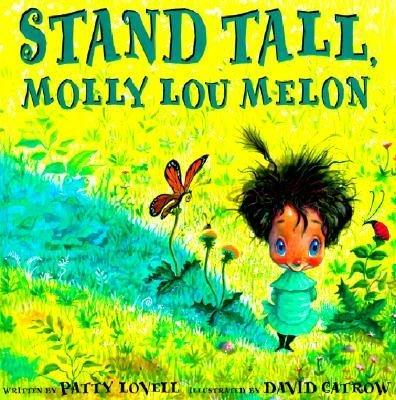
Anyone that knows me is aware that height is, um, sort of an issue for me. Don’t get me wrong, I’m not generally insecure about my looks, but I think everyone has that one “sensitive subject” they’re not comfortable about themselves, and at 5’10″, being tall is mine. And no annoying “But being tall is so great!” comments are going to change that.
So I could appreciate the levity and message of the latest book I’ve come across at work: Stand Tall, Molly Lou Melon by Patty Lovell, and illustrated by David Catrow. Molly Lou, the shortest, buck-toothiest, bullfrog-iest new girl in class, shines because she follows her grandmother’s advice to always, “Walk as proudly as you can and the world will look up to you.” She’s got confidence that (literally) bowls over the school bully, and it’s fantastic. This is the kind of both entertaining and meaningful read that makes me want to shove it in the New York Times’ snotty face and say, “THIS IS WHY PICTURE BOOKS ARE SO GREAT!” Phew! Anywho… moving on…
Designing “extras” for Molly Lou’s 10th anniversary got me to thinking about those handmade growth charts scrawled up the doorframes of classic American households. Remember those? Well, I wanted to see if there were some pre-made growth charts with a bit of design flair. Turns out, you can pretty much find a colorful growth chart for kids on any theme – no matter how tall or small!
Here were some of my favorites:

Heirloom Boxed Set Growth Chart – via Design Mom

Grow-With-Me Scroll Chart – via Family Style

Chalkboard Paint DIY Growth Chart – via OhDeeOh
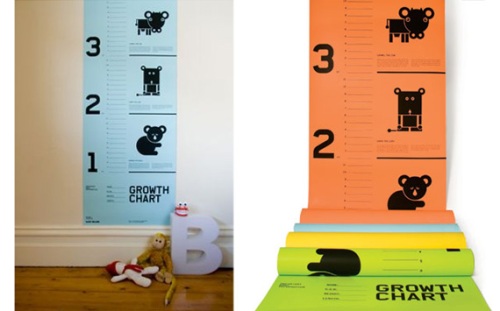
Basic Shapes Growth Chart –
1 Comments on Stand Tall! Growth Charts, last added: 10/8/2010

Have you picked up a copy of Deyan Sudjic's new biography of architect Norman Foster? If not, this article from Sunday's New York Times should definitely pique your interest in the book. While NORMAN FOSTER: A LIFE IN ARCHITECTURE is primarily a professional biography, it also discusses Foster's idealism, design aesthetic and the Masdar development that received so much attention from the Times. Go here to read the full article, and check out a brief excerpt below!
Back in 2007, when the government here announced its plan for “the world’s first zero-carbon city” on the outskirts of Abu Dhabi, many Westerners dismissed it as a gimmick — a faddish follow-up to neighboring Dubai’s half-mile-high tower in the desert and archipelago of man-made islands in the shape of palm trees. 
Designed by Foster & Partners, a firm known for feats of technological wizardry, the city, called Masdar, would be a perfect square, nearly a mile on each side, raised on a 23-foot-high base to capture desert breezes. Beneath its labyrinth of pedestrian streets, a fleet of driverless electric cars would navigate silently through dimly lit tunnels. The project conjured both a walled medieval fortress and an upgraded version of the Magic Kingdom’s Tomorrowland.
Well, those early assessments turned out to be wrong. By this past week, as people began moving into the first section of the project to be completed — a 3 ½-acre zone surrounding a sustainability-oriented research institute — it was clear that Masdar is something more daring and more noxious.
Norman Foster, the firm’s principal partner, has blended high-tech design and ancient construction practices into an intriguing model for a sustainable community, in a country whose oil money allows it to build almost anything, even as pressure grows to prepare for the day the wells run dry. And he has worked in an alluring social vision, in which local tradition and the drive toward modernization are no longer in conflict — a vision that, at first glance, seems to brim with hope.
Continued
here.
Recently the New York Times published a major story featuring Jeffrey Arnett’s research on “emerging adulthood,” his term for the age period from 18 to 29. The article received tremendous attention (boosting it to the position of top emailed story) and Arnett was soon asked to appear on the Today Show, among other major media outlets around the world. In the original post below, he expands on the ideas previously presented and responds to stereotypes about emerging adults.
By Jeffrey Arnett
How do you know when you’ve reached adulthood? This is one of the first questions I asked when I began my research on people in their twenties, and it remains among the most fascinating to me. I expected that people would mostly respond in terms of the traditional transition events that take place for most people in the 18-29 age period: moving out of parents’ household, finishing education, marriage, and parenthood. To my surprise, none of these transition events turned out to hold much importance as markers of adulthood. In fact, finishing education, marriage, and having at least one child have consistently ended up near the bottom in importance in the many surveys that I and others have done in the United States and around the world over the past decade.
Consistently, across countries, ethnic groups, gender, and social classes, the “Big Three” criteria for reaching adulthood are these: 1) Accept responsibility for yourself, 2) Make independent decisions, 3) Become financially independent.
What the Big Three have in common is that they all denote self-sufficiency. For emerging adults, adulthood means learning to stand on your own as a self-sufficient person. Only when you have attained self-sufficiency are you ready to take on the obligations of marriage and parenthood. Because the Big Three all occur gradually rather than as one-time events, most emerging adults feel in-between until at least their mid-twenties, on the way to adulthood but not there yet.
There are negative stereotypes that have sprung up with regard to emerging adults: that they are lazy, spoiled, selfish, and never want to grow up. These stereotypes are common and extremely unfair. Lazy? Have you noticed lately who is pouring your coffee, working the retail counter, mowing the lawns? It’s mostly emerging adults who are doing the crummy, low-paying, no-benefits jobs older adults try to avoid. Emerging adults often hold one or more of these jobs and combining them with going to school as they try to work their way up to something better. Spoiled and selfish? Who is it that is applying in record numbers to Teach for America, Americorps, and the Peace Corps, among other volunteer organizations? Not their Baby-Boomer critics, but emerging adults. Never want to grow up? By age 30 most people are married, have at least one child, and are committed to a stable career path. Why begrudge them the freedom of their twenties to try to make the best possible adult lives for themselves, and to have fun and adventures that they will not be able to have later?
Whatever older adults think of it, emerging adulthood is here to stay as a stage of the life course. Instead of tearing them down, as parents and as a society we should be building them up and giving them the support they need to enjoy their twenties and have a successful entry into the responsibilities of adult life.
Jeffrey Jensen Arnett, Ph.D. is a Research Professor in the Department of Psychology at
0 Comments on 20-somethings: NOT lazy, spoiled, or selfish as of 1/1/1900
 The First Book Marketplace is available to teachers and program leaders who serve children from low-income families, and we work hard to make sure that we’re able to offer high-quality titles that those teachers and program leaders tell us their kids want to read.
The First Book Marketplace is available to teachers and program leaders who serve children from low-income families, and we work hard to make sure that we’re able to offer high-quality titles that those teachers and program leaders tell us their kids want to read. 















![iStock_000002070879Small[1]](http://blog.firstbook.org/wp-content/uploads/2010/11/iStock_000002070879Small1-300x225.jpg)










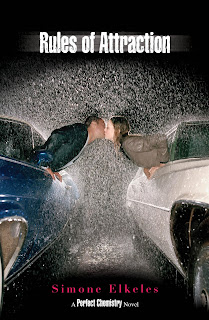
.jpg)
.jpg)


.jpg)
Congratulations to you and your writers. You obviously know how to pick winners. Enjoy your happy dance. When life is this good, you've gotta dance!
Congratulations Kristin - this is fabulous news for you and your clients! Wonder what next year will hold? Then again, maybe this year can get even better still :)
Most excellent. Bask in your much-deserved glory. ;-)
Congratulations, Kristin! Reach for the stars!
Congratulations! It made me happy, too, just reading your entry :)
Nothing left to say but congrats!
And to think, the year's only a little more than half-over. Congrats.
That is awesome! Happy for you and the authors both. :-)
Congrats! :)
Congrats! I loved Hotel on the Corner of Bitter and Sweet. :)
The covers are ALL awesome. Obviously the content delivers. There are so many layers to creating these amazing stories. Dance and sing!
Readers are thrilled too, though they'll never know the depth of gratitude they owe to you. So I'll say it for all those clueless readers, Thanks, Kristen, for being you.
That is absolutely fantastic, Kristen. Congratulations!
Hope you're going to go celebrate?
Congrats!
Congratulations! :)
Can't wait to see how you top this one! ;-)
Congrats to you and your authors!
Amy
Congratulations!
Congratulations to you all!
Congratulations! It is obvious that you have the skill and knowledge to know a successful novel when you see it. And congrats to all your authors for sharing their excellent work with us!!
That must be a great feeling! Congrats!
Congrats! Having devoured it this week I KNOW Ally Carter's "Uncommon Criminals" deserves to be on that Best Seller list and I'm sure the others do too!
Congratulations! This is fantastic news!
Hotel on the Corner of Bitter and Sweet has been on bestseller lists for awhile, now, hasn't it?
YAY!!!
Awesome news--you deserve to happy dance!
Isn't it lovely to read about a 'good news' event:):):) congratulations to everyone involved...
Olga from http://[email protected]
I'm so happy for you. You deserve to do the happy dance!
I'm confused about something. I thought the NY Times doesn't accept self published books on their list. I'm thrilled for Courtney, but how did Unlocked get on the NY Times ebook list if it's self published? Does this mean they will allow other self-published authors on their list now?
I haven't read the other books. But I did read...and re-read..."Hotel" and thought it was the best book I'd read in years. I seriously want this to be number one now!!
Can you pick 'em or what?
Seriously, congratulations to you and each one of the authors for making the list. That's amazing!
C'mon, Milestones!!!! (No, really, it's all right. Keep 'em coming.)
Bess Morgan
CONGRATULATIONS! It couldn't have happened to a nicer agent!
I'm confused about something. I thought the NY Times doesn't accept self published books on their list. I'm thrilled for Courtney, but how did Unlocked get on the NY Times ebook list if it's self published? Does this mean they will allow other self-published authors on their list now?
Some other self-published books have been on the list. (Barbara Freethy, John Locke, Victorine Lieske, Nancy Johnson, Stephanie McAfee.) Others have not. (Amanda Hocking).
Speculation abounds, but I chalk it up to the NYT being squirrely and inscrutable just to get its inscrutability on.
Regardless, I'll take it.